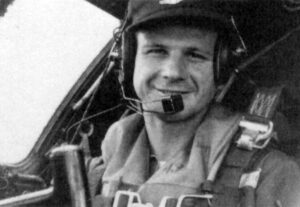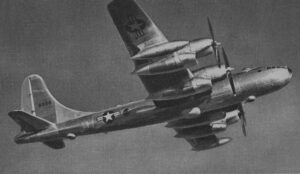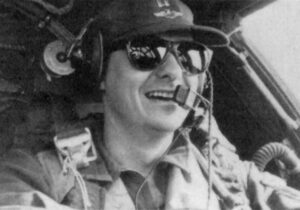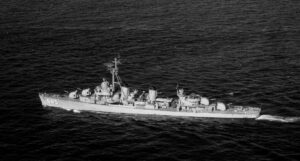
 The mission began on July 29, 1953. The B-50 Superfortress piloted by Captain Stanley K O’Kelley had a total of seventeen crewmembers aboard. Its mission was a reconnaissance flight over North Korea. It took off from Honshu, Japan. As the plane headed out across the Sea of Japan, on its way to North Korea, it was intercepted and shot down by a pair of MiG-17s (or possibly MiG-15s) piloted by two Soviet pilots (Yablonskiy and Rybakov), south of Askold Island near Vladivostok. They immediately opened fire, and quickly shot down B-50 Superfortress number 15830. The plane crashed into the Sea of Japan. Amazingly, there was one survivor, and unfortunately, the rest of the crew died in the crash.
The mission began on July 29, 1953. The B-50 Superfortress piloted by Captain Stanley K O’Kelley had a total of seventeen crewmembers aboard. Its mission was a reconnaissance flight over North Korea. It took off from Honshu, Japan. As the plane headed out across the Sea of Japan, on its way to North Korea, it was intercepted and shot down by a pair of MiG-17s (or possibly MiG-15s) piloted by two Soviet pilots (Yablonskiy and Rybakov), south of Askold Island near Vladivostok. They immediately opened fire, and quickly shot down B-50 Superfortress number 15830. The plane crashed into the Sea of Japan. Amazingly, there was one survivor, and unfortunately, the rest of the crew died in the crash.
Captain John Ernst Roche was that survivor, and when it became known that the bomber had failed to return, a search was started. It was thought that some of the other crew might have survived, and life rafts were dropped, but no one else was saved in the end. It was thought that at least four of them (and possibly more) were seen sitting in the raft. Also seen were nine Soviet PT-type boats in the area and at least six of them were heading to the location where debris from the aircraft was later discovered. A Soviet trawler was also spotted in the approximate area. Knowing that, I suppose any of the other survivors were killed. The United States conducted a thorough search of the area by air and sea and was assisted by an Australian ship near the crash site. The search was halted due to dense fog and approaching darkness, and the search was resumed on the morning of July 30, 1953. Captain John Roche, co-pilot of the plane, was wounded but survived the crash by holding onto pieces of the wreckage. He was finally picked up by the Navy ship USS Picking in the early morning hours of July 30, 1953, after floating in the Sea of Japan for about 22 hours. Unfortunately, no other survivors were found. The bodies of Captain Stanley O’Kelley and Master Sergeant Francis Brown were later recovered along the coast of Japan. The remaining 14 members of the crew, which included Robert Stalnaker, were never found. The crew members were First Lieutenant Frank E Beyer (MIA), Master Sergeant Francis L Brown (body recovered), First Lieutenant Edmund J Czyc (MIA), Staff Sergeant Donald W Gabree, (MIA), Airman First Class Roland E Goulet (status unknown), Staff Sergeant Donald G Hill (MIA), First Lieutenant James G Keith (KIA), Captain Stanley K O’Kelley (body recovered), Airman Second Class Earl W Radelin Jr (MIA), Captain John E Roche (rescued the next day on July 30, 1953), Airman Second Class, Charles J Russell (MIA), First Lieutenant Warren J Sanderson (MIA), First Lieutenant Robert E Stalnaker (MIA), Major Francisco J Tejeda (MIA), Captain John C Ward (MIA), First Lieutenant Lloyd C Wiggins (MIA), and Airman Second Class James E Woods (MIA).
The B50 Superfortress number 47-145 (Manufacture Number 15830) was built by Boeing. It was delivered to the US Air Force (USAF) as B-50B-50-BO Superfortress serial number 47-145. So that the bomber could be 
 used as a spy plane, it was modified as RB-50G ELINT with additional radar and B-50D type nose, sometimes also referred to as RB-50D. It was then assigned as a spy plane, to the 91st Strategic Reconnaissance Squadron (91st SRS) based at Yokato AFB. It was working in that capacity when it was shot down.
used as a spy plane, it was modified as RB-50G ELINT with additional radar and B-50D type nose, sometimes also referred to as RB-50D. It was then assigned as a spy plane, to the 91st Strategic Reconnaissance Squadron (91st SRS) based at Yokato AFB. It was working in that capacity when it was shot down.


Leave a Reply